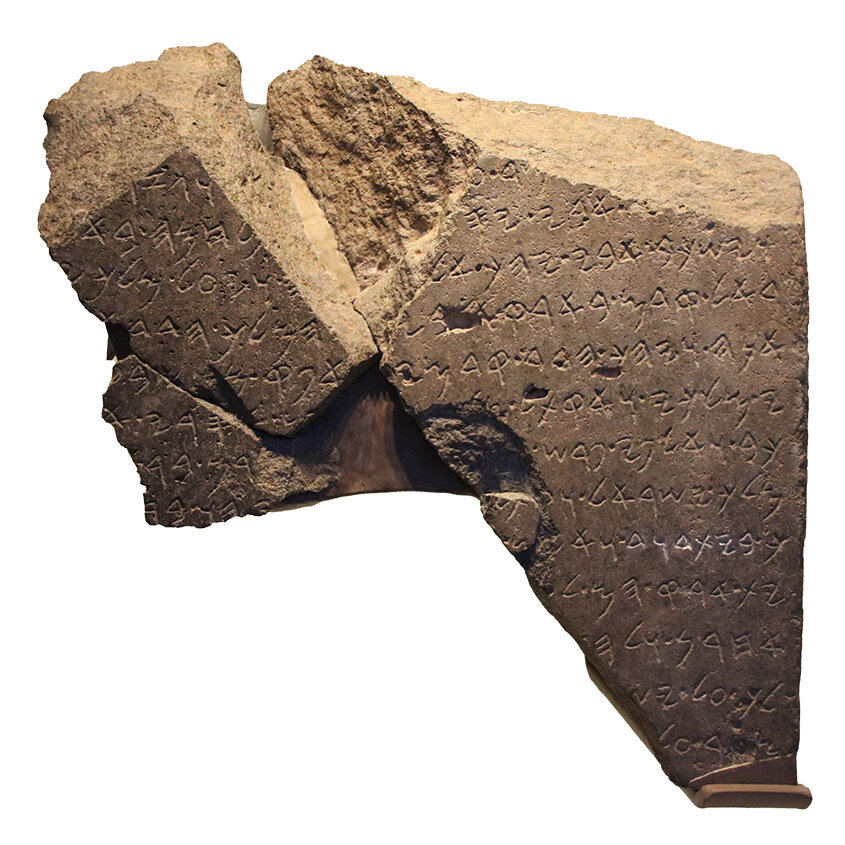Now at Armstrong Auditorium: The Tel Dan Stele

Now at Armstrong Auditorium: The Tel Dan Stele
Now at Armstrong Auditorium: The Tel Dan Stele
“[M]y father lay down; he went to [his fathers]. And the king of [Is]rael formerly went up to my father’s land. And as for me, Hadad made me king. And Hadad went before me and I went out from the seven … of my kingdom; and I killed seventy kings, who harnessed thou[sands of cha]riots and thousands of horsemen. [And I killed Jo]ram, the son of A[hab], king of Israel, and [I] killed [Ahaz]iah, the son of [Joram, kin]g of the house of David. And I set [ ] their land into desolation … [r]uled over Israel. …
This record of conquest was inscribed in stone in the ninth century b.c., most likely by Hazael, king of Damascus. Roughly 2,800 years later, in 1993 and 1994, archaeologists uncovered fragments of the monument at the Tel Dan site in northern Israel. It became a prized artifact on display at the Israel Museum. Now through late November, it is at Armstrong Auditorium, on loan as part of the “Kingdom of David and Solomon Discovered” exhibit.
Visit the exhibit to see this ancient treasure yourself, rock-solid proof of “the house of David.”

“Kingdom of David and Solomon Discovered” is sponsored by the Armstrong Institute of Biblical Archaeology and features loans from the Israel Antiquities Authority and the Israel Museum that piece together the story of the 10th century b.c. Kingdom of Israel with dozens of authentic artifacts, replicas, virtual reality tours and more. But the Tel Dan Stele, arguably the greatest archaeological proof for the existence of David, is a real gem to add to the exhibition’s already heavyweight cast. “This was the first [confirmed] appearance of the term ‘David’ in an archaeological text and, given the context, could only refer to the historical progenitor of the Davidic line,” Randall Price and H. Wayne House wrote in the Zondervan Handbook of Biblical Archaeology. “By deduction, if there was a ‘house of David,’ there had to be a ‘David’ to have a house.”
“The discovery of the stele caused an earthquake in the archaeological community,” “Kingdom of David and Solomon Discovered” curator Brad Macdonald said. “It vanquished the common belief that King David was a fictional character and bolstered the credibility of the Bible as a valuable historical source. This is just one reason it is one of the most important archaeological discoveries ever found.”
The stele, which dates to roughly 100 years after Solomon’s death, not only mentions David by name but also establishes him as the head of an influential dynasty. Even without the statement “the house of David,” this monument would still be remarkable for its corroboration of the biblical kings Ahab and Joram of Israel (1 Kings 16:29; 2 Kings 3:1) and of King Ahaziah of Judah (2 Kings 8:24). The Bible makes indirect references to the Syrian god Hadad (e.g. 1 Kings 20:1), and it identifies Hazael as a powerful warrior and destructive enemy of Israel (2 Kings 8:12). Intriguingly, the Bible says Joram’s coup-plotting general Jehu was the kings’ killers. Where Jehu fits within the Tel Dan Stele’s narrative is a mystery, but Jehu and Hazael were contemporaries.

Hazael was a heathen king who harmed Israel greatly. Yet intriguingly, the Bible notes that God commissioned the Prophet Elijah to anoint Hazael king of Syria. Elijah’s successor, Elisha, fulfilled the commission.
The Bible shows that God used Hazael to correct Israel for its sins and to move His overall plan for mankind forward. In a sense, to this day, God is still doing that. David is mentioned almost 900 times in the Holy Bible, almost as many times as Jesus Christ. The Bible describes the kingdom of Israel during the reigns of David and Solomon as powerful, influential and monumental.
Yet archaeologists and other scholars regarded descriptions of David and specifically descriptions of his kingdom as fanciful myth. It was Hazael’s stele that caused the scholarly consensus to accept David as a literal historical figure.
Armstrong Auditorium will exhibit the Tel Dan Stele through November 25. “Kingdom of David and Solomon Discovered” continues through Jan. 17, 2025.
